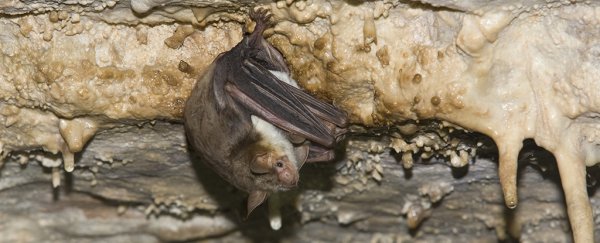Scientists have discovered a clever mimicry trick used by some bats: they'll buzz like hornets when they think they're under threat from predators, giving the sonic impression they're more dangerous than they actually are.
It's the first time behavior like this has been recorded in mammals, but it happens elsewhere in the animal kingdom – such as when the wings of moths are patterned to appear like the insect is actually a different, much more dangerous species. The technical term for it is Batesian mimicry.
The team behind the new study on bats says their findings yield an important insight into both evolutionary processes and the ways animals will try and defend themselves when cornered.
"In Batesian mimicry, a non-armed species imitates an armed one to deter predators," says ecologist Danilo Russo, from the Università degli Studi di Napoli Federico II in Italy.
"Imagine a bat that has been seized but not killed by the predator. Buzzing might deceive the predator for a fraction of a second – enough to fly away."
It was during work in the field that Russo and his colleagues noticed greater mouse-eared bats (Myotis myotis) making buzzing sounds whenever the researchers handled animals that had been caught in nets. It seemed like some kind of distress call, but it wasn't until years later that work for this study got underway.
To confirm their hunch about the buzzing being a type of Batesian mimicry, the researchers compared the strong similarities between the buzzing sounds emitted by the bats and stinging social hymenopteran insects (such as wasps and bees).
They then played these sounds to some bat-eating predators: wild owls and owls raised in captivity. While the reactions varied – perhaps due to the birds' previous experiences – there was also some general consistency when it came to buzzing from both insects and bats, and to standard, non-buzzing bat sounds.
"Owls consistently reacted to hymenopteran and bat buzzes in the same way, by increasing the distance from the speaker," write the researchers in their published paper.
"Whereas they approached the latter in response to the control stimulus, as expected from a non-mimetic vocalization produced by potential prey."
The owls who hadn't been raised in captivity showed the strongest adverse reaction to both bat and insect buzzing, as they're likely more knowledgeable about potential harms than owls bred in captivity.
One other notable finding: when the acoustics were analyzed to show only sounds that owls can hear, the similarities to insects were more pronounced.
It's possible that this mimicry has evolved due to bats and insects sharing a lot of the same spaces (including caves and crevices in rocks), but this kind of acoustic mimicry is rare – and it's interesting to see bats borrowing from another species to put off their predators.
"It is somewhat surprising that owls represent the evolutionary pressure shaping acoustic behavior in bats in response to unpleasant experiences owls have with stinging insects," says Russo.
"It is just one of the endless examples of the beauty of evolutionary processes!"
The research has been published in Current Biology.
